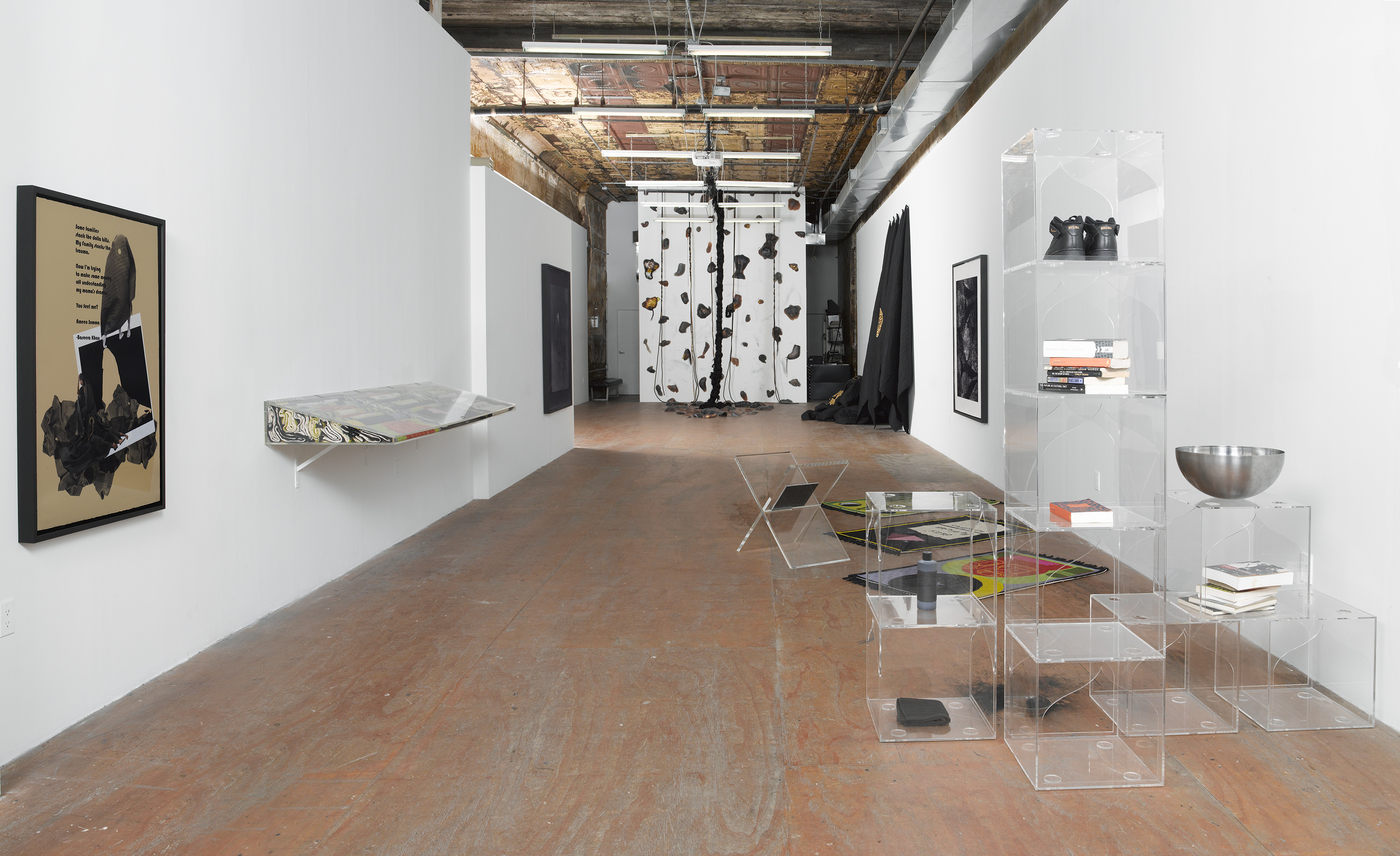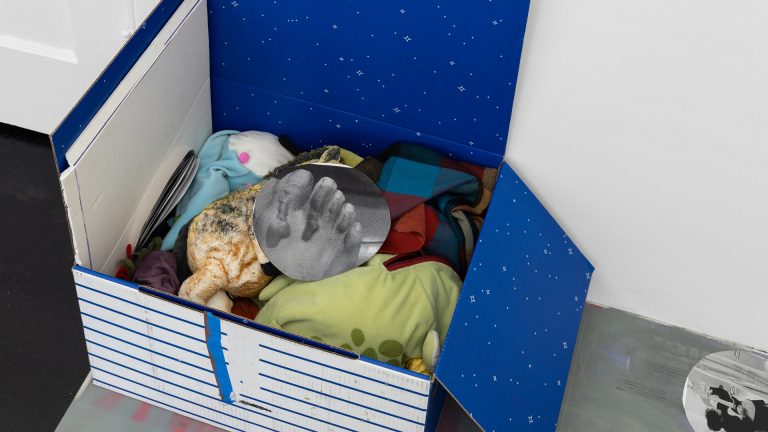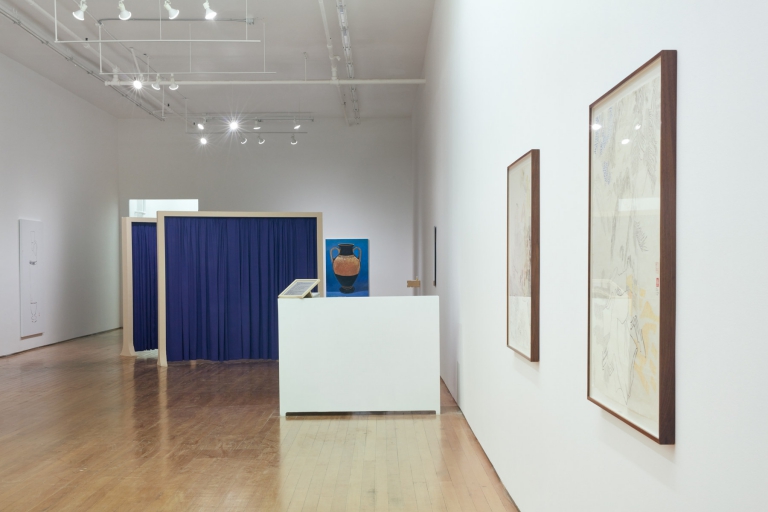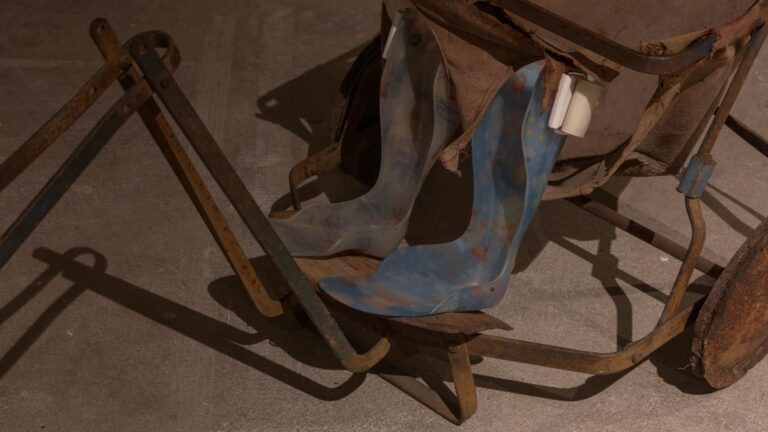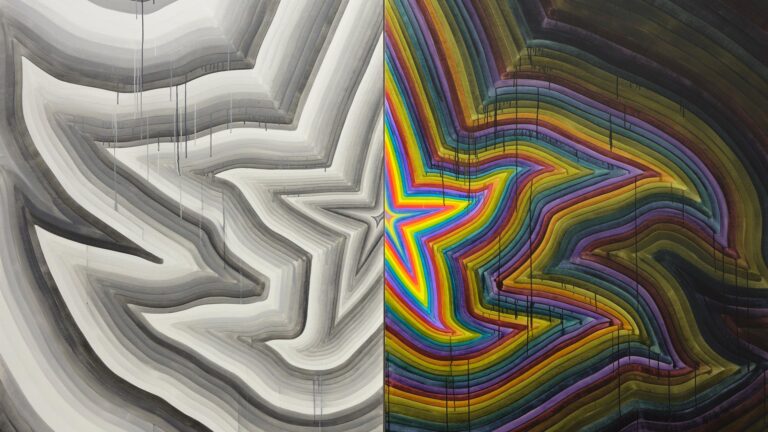Artist: Baseera Khan
Exhibition title: iamuslima
Venue: PARTICIPANT INC, New York, US
Date: February 26 – April 2, 2017
Photography: all images copyright and courtesy of the artist and PARTICIPANT INC
From February 26 – April 2, 2017, PARTICIPANT INC is pleased to present Baseera Khan, iamuslima, the artist’s first solo exhibition in New York. Works produced for iamuslima deal with historical identity – traditional representations and their misrepresentations, which have led to volatile social environments globally and most notably within capitalist-driven societies such as the U.S. Volatility creates needs for self-censorship and secrecies among people who are marginalized and othered, even within groups who are also othered. As a subject of immigration, refugee status, and being a femme Muslim in the U.S. right now, Khan’s work strategically considers how to manage imposed stress and trauma. The work externalizes a lesson learned by Khan at a young age: self-censorship and secrecies can be aestheticized. Deploying linguistic shifts and fashion as political mediums, iamuslima bounces around textiles, archives, performance, and sculpture. PARTICIPANT has a history of creating sanctuary for people whose lives are rendered unsafe because of governmental policies or public views regarding gender, health, and sexuality. The works in iamuslima function not only as an extension of that history, but also manifest an intersectional American experience, in terms of the works themselves as well as the collective spirit of their making.
True revolution can often be trapped by its treatment through traditional photography and its historical archive. Creating lexicons on her own terms, Khan challenges the evidentiary capabilities of all forms of documentation. An important reference is Jean Genet’s 1986 novel Prisoner of Love, with works evolving from Khan’s use of family heirlooms specifically mined for aspects of displacement and migration. Genet’s lived experience is also a key referent for understanding a timeline of geopolitical revolutionary activities, as he spent time in membership of the Palestinian Liberation Front in Western Asia and within the Black Panther Party in the U.S. Investigating fields of interpersonal reconciliation, Khan’s semiotic readings of objects, photography, and text recount a complex sense of estrangement, kinship, and exile.
Central to the exhibition is Braidrage, a 12×15 foot rock climbing wall, whose ‘rocks’ are formed from corners of the artist’s body cast in resin, with hair and chains embedded in various shades of black and brown. Climbing regiments levels of anxiety through a training process, in which learning functions as a practice of decolonizing the mind. On opening night, Khan will climb this wall, wearing a pair of Nike Air Force mid-tops upon which iamuslima is inscribed through Nike’s ID tag project. Early on, Khan found out that the company was being sued for not allowing a customer to embroider the word ‘Muslim’ on the shoe; however, many other religious words were approved. Through a calculated technique of misspelling, Khan legitimized her design.
Five large-format screen prints structure the exhibition, based on Khan’s version of the five pillars of Islam: Pilgrimage (visiting the Kaaba, which is adorned in black cloth as are so many practicing women), Fasting (a 30-day fast by the lunar calendar), Oneness (belief in monotheism), Zakat (donating 10% of your monetary value every year), and Prayer (prostrating in submission five times a day to an entity outside of your body). Closely related to the prints, arrangements of performative objects, Acoustic Sound Blankets, are embroidered with patterns that have been in Khan’s family for generations. Women archive and embroider these artifacts when one is born, married, or passing. Holes are cut out to appear like the patterns on holy books. In previous performances for the camera, Khan has invited people to share intimacies, seek safety underneath these blankets concealing, like the veil. Since recent protests, it has become a common activity to meet in groups to make protest banners and, in many instances, holes are cut out of fabric to allow protesters to wear messages in lieu of holding signs. Khan has since received emails from activists requesting acoustic blankets to protect themselves from sound waves from military shock bombs used to break up crowds.
Also fabricated for the exhibition, Khan’s Psychedelic Prayer Rugs (Lunar Count Down, Act Up, and Purple Heart) were made in collaboration with rug makers in Kashmir, India, who interpreted designs supplied by the artist. Sourced from a need to express Khan’s personal experience as a pocq femme Muslim woman in the U.S., the designs are based on secret psychedelic spaces that adhere to the reverence of practicing prayer, but also push against ideas of sexuality, military, and imprisonment. These issues, inherent to religion, are often used by the State to control and confuse people, and are deployed within interpersonal relationships and family structures to subvert the need to break hetero-normative boundaries. In this context, Psychedelic Prayer Rugs are reinvented as portals of meditation to activate a different personal consciousness – being awake. Occupying an area of the exhibition equipped with a shelving unit designed to hold people’s shoes, visitors who wish to engage with the rugs are welcome to perform ablution. This area will function as a Reading Room, On Purpose, where one can read a variety of books and view personal archives that comprise research related to the exhibition. The Reading Room, On Purpose contains a handcrafted book, compiled by the artist, called Core-On (pronounced ‘core dash on’) – Khan’s Qur’an, which tells the story of her work through images, notes, and mappings.
Baseera Khan is a New York based artist. Her visual and written work performs patterns and repetitions of emigration and exile shaped by economic, social, and political changes throughout the world with special interests in decolonization processes. She recently exhibited in BRIC Biennial, Brooklyn, NY (2016) at The Weeksville Heritage Center. Her past exhibitions include Subject to Capital, Abrons Art Center, New York (2016), Arrivals, Out to See, New York City (2014), TX*13 Texas Biennial 5th Anniversary Survey Group Exhibition, Texas (2014), Picturing Parallax, San Francisco State University, California (2011), Hindu Kush, and Hosfelt Gallery, San Francisco (2009). She was an artist-in-residence at the Skowhegan School of Painting and Sculpture, Artist Residency, Skowhegan, Maine (2014). She was recently an International Fellow in Israel/Palestine through Apexart, New York (2015). She was also a participating artist in Process Space LMCC (2015). Khan is currently a 2017 Artist in Residence at Abrons Art Center, NYC and part-time faculty at Parsons, The New School for Design. She received her M.F.A. at Cornell University (2012) and B.F.A from the University of North Texas (2005).



